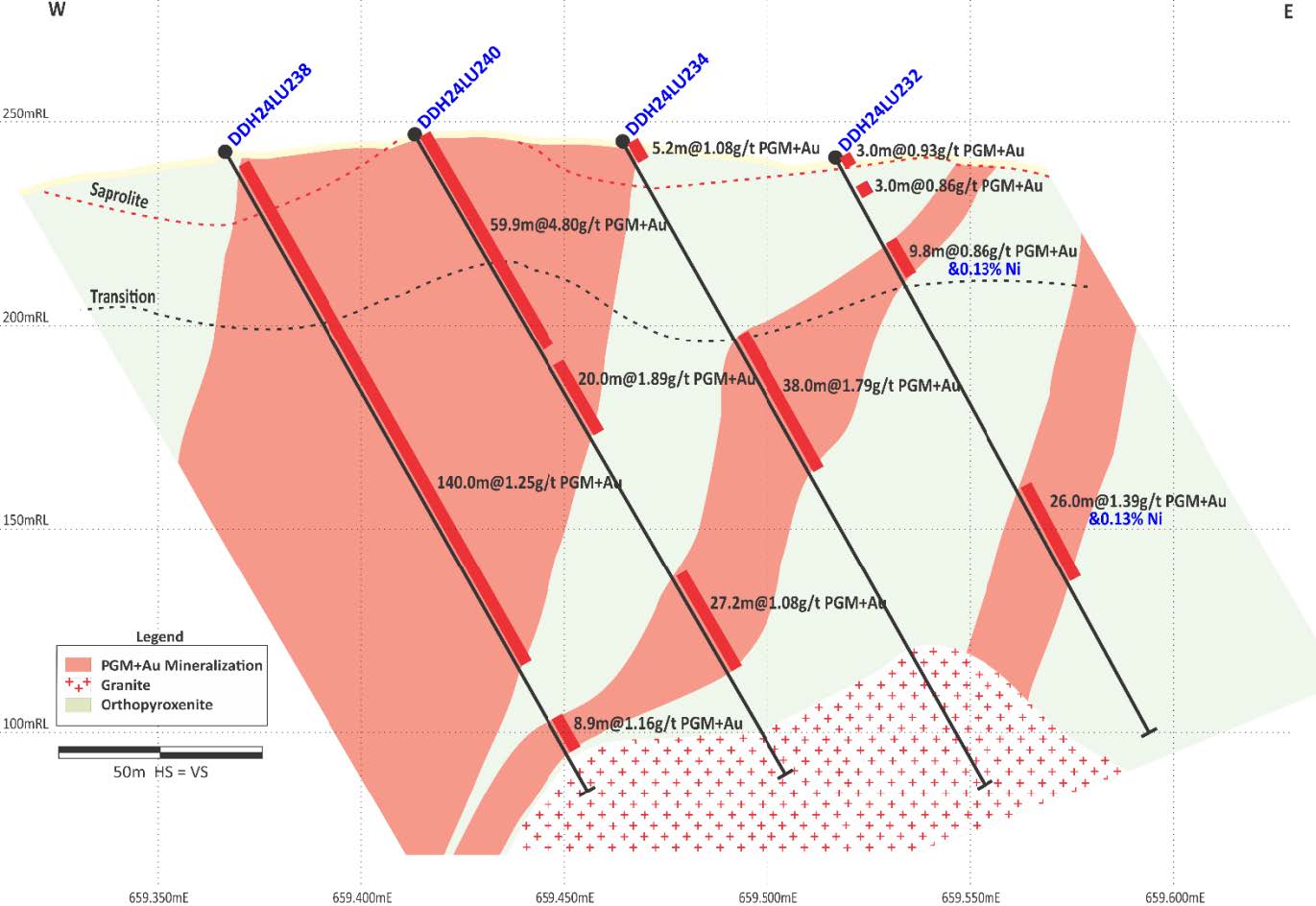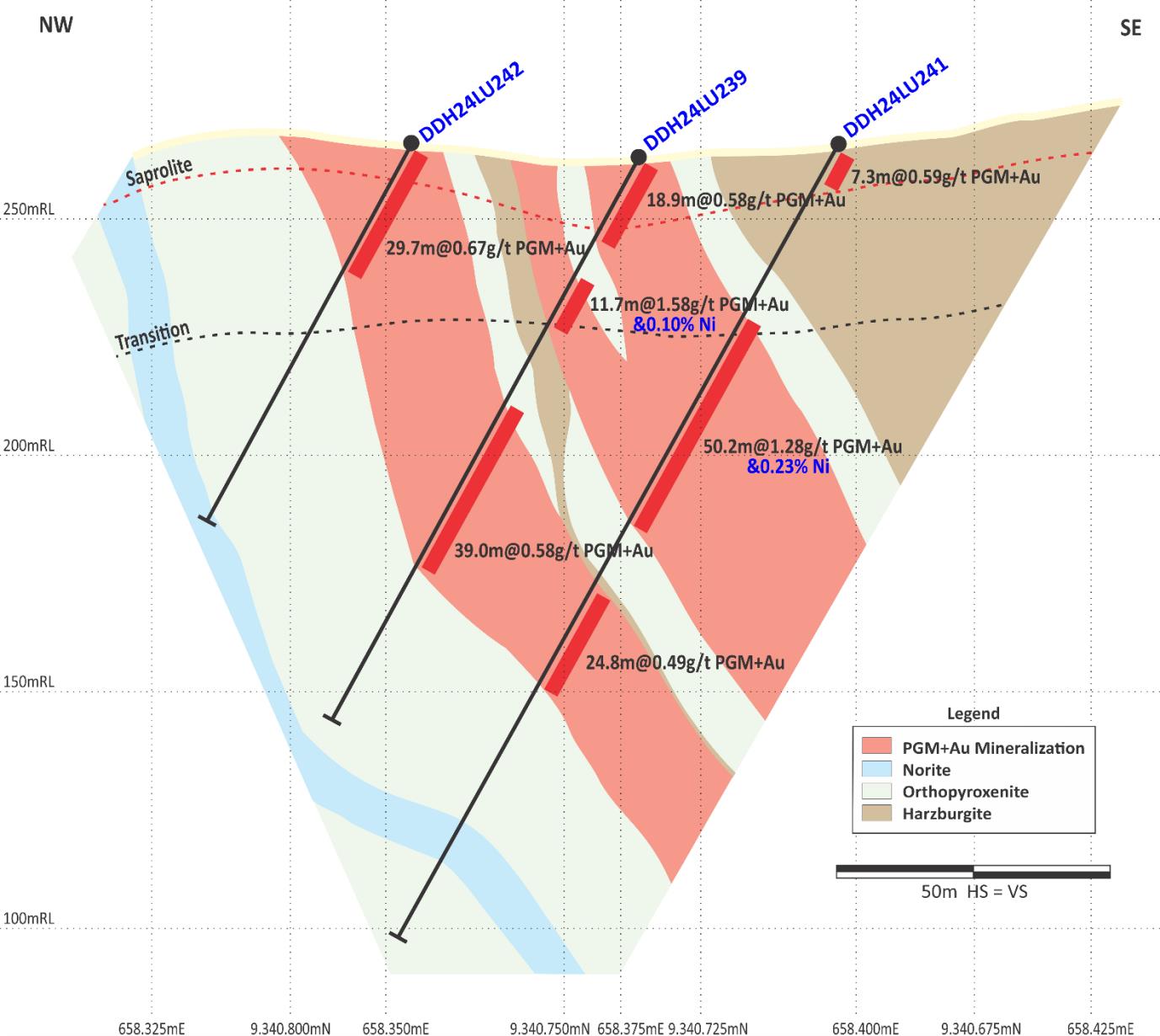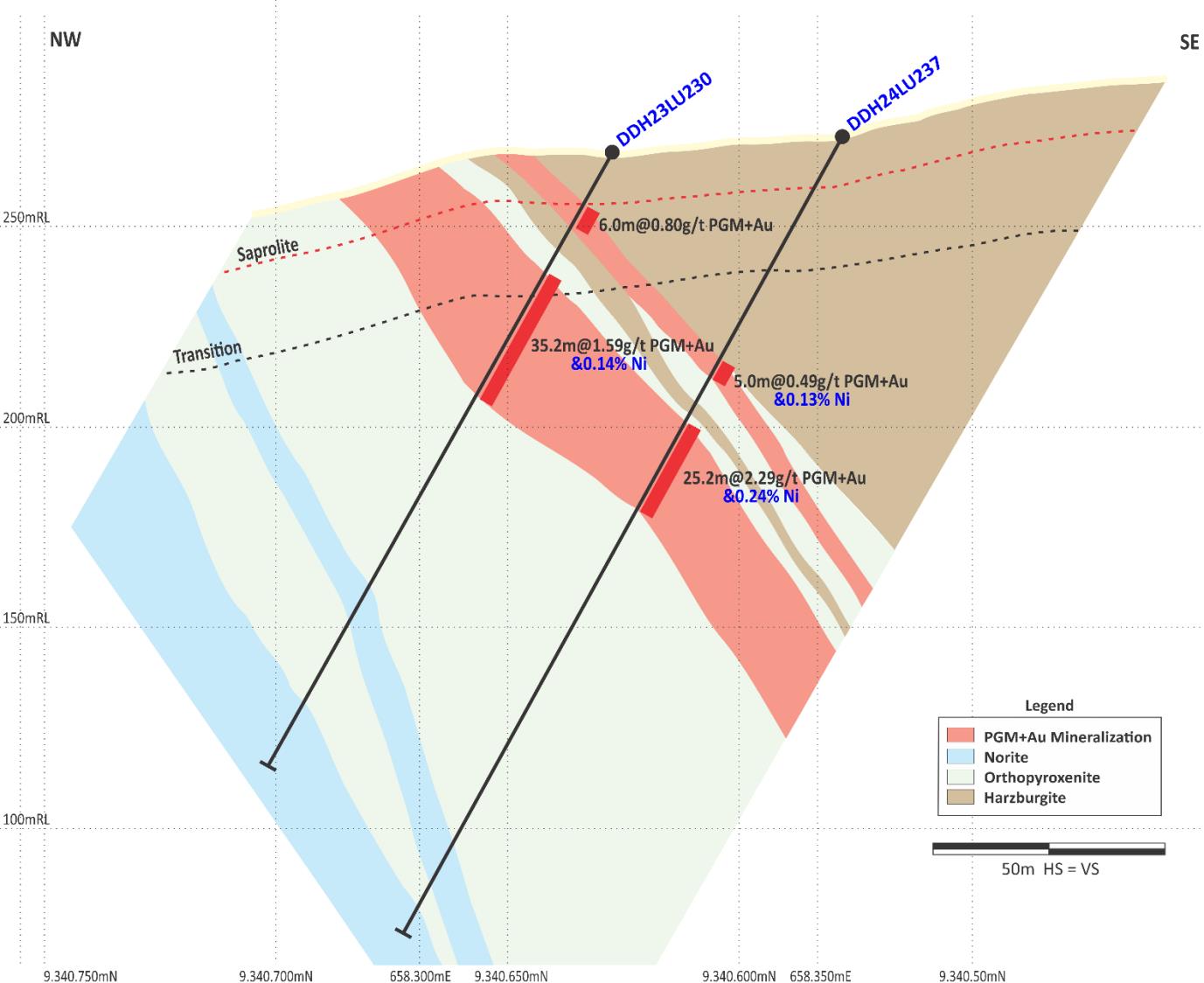Highlights include 59.9m at 4.80g/t PGM+Au including 42.9m at 5.50g/t PGM+Au, 0.21% Ni, and 140.7m at 1.25g/t PGM+Au and 45.7m at 1.71g/t PGM+Au, 0.22% Ni
VANCOUVER, May 06, 2024 – Bravo Mining Corp. (TSX.V: BRVO, OTCQX: BRVMF), (“Bravo” or the “Company”) has received assay results from nine diamond drill holes (“DDH”), four from the North Sector and five from the Central Sector at its 100% owned Luanga palladium + platinum + rhodium + gold + nickel project (“Luanga” or “Luanga PGM+Au+Ni Project”), located in the Carajás Mineral Province, state of Pará, Brazil.
“Drilling results at Luanga continue to demonstrate upside, notably with DDH24LU240 returning the highest grade/thickness to date. Additionally, DDH24LU038 stands out as the thickest mineralized drill intersection, extending over 140m from surface,” said Luis Azevedo, Chairman and CEO. “Drilling continues to show increasing nickel sulphide grades at depth in the Central Sector, while the North Sector shows widening of multiple zones of mineralization, which has the potential to significantly improve ratios of near surface mineralized to unmineralized material. These positive factors strengthen confidence for on-going drilling.”
Highlights Include:
- Drilling in the North Sector continues to show improvements in both mineralized grade and thickness compared to previously reported drilling in this sector. Grades in and around the transitional weathering zone are higher, influenced by supergene enrichment, as shown on Section 1:
- 59.9m at 4.80g/t PGM+Au, including 42.9m at 5.50g/t PGM+Au, 0.21% Ni
- 140.7m at 1.25g/t PGM+Au
- Mineralization intersected on all three drill sections are at shallow depths (<150m), which augurs well for the future. Furthermore, the substantial volumes of mineralization, indicated by these wide intersections near surface, could support lower strip ratios in these areas.
- Mineralization remains open at depth, while evidence of increasing PGM and nickel grades at depth remains a common theme in the Central Sector.
|
HOLE-ID |
From |
To |
Thickness (m) |
Pd |
Pt |
Rh |
Au |
PGM + Au |
Ni* (%) Sulphide |
TYPE |
|
(m) |
(m) |
(g/t) |
(g/t) |
(g/t) |
(g/t) |
(g/t) |
||||
|
DDH24LU236 |
25.30 |
28.30 |
3.00 |
2.16 |
5.53 |
1.15 |
0.07 |
8.91 |
NA |
LS |
|
And |
178.25 |
187.25 |
9.00 |
1.11 |
0.93 |
0.22 |
0.02 |
2.28 |
0.02 |
FR |
|
DDH24LU237 |
79.70 |
104.90 |
25.20 |
1.52 |
0.65 |
0.08 |
0.05 |
2.29 |
0.24 |
FR |
|
DDH24LU238 |
5.00 |
145.70 |
140.70 |
0.57 |
0.66 |
0.01 |
0.01 |
1.25 |
NA |
Ox/FR |
|
DDH24LU240 |
0.00 |
59.85 |
59.85 |
3.02 |
1.46 |
0.26 |
0.06 |
4.80 |
NA |
Ox/FR |
|
Including |
0.00 |
17.00 |
17.00 |
1.98 |
0.85 |
0.16 |
0.04 |
3.04 |
NA |
Ox |
|
Also Including |
17.00 |
59.85 |
42.85 |
3.43 |
1.71 |
0.30 |
0.06 |
5.50 |
0.21 |
FR |
|
And |
64.85 |
84.85 |
20.00 |
0.88 |
0.85 |
0.15 |
0.01 |
1.89 |
0.01 |
FR |
|
DDH24LU241 |
75.80 |
86.80 |
11.00 |
1.93 |
0.65 |
0.10 |
0.07 |
2.76 |
0.32 |
FR |
|
DDH24LU244 |
34.56 |
80.30 |
45.74 |
1.14 |
0.43 |
0.08 |
0.06 |
1.71 |
0.22 |
FR |
|
Notes: |
All ‘From’, ‘To’ depths, and ‘Thicknesses’ are downhole. ‘NA’ Not applicable for Oxide material. |
Luanga Drilling Update
Results from nine diamond drill holes have been received from the North and Central Sectors. All the drill holes herein reported are angled holes (-60 degrees), towards a 090° azimuth in the North and 330° azimuth in the Central Sector. Together, this set of drill holes comprise a total of 1,581 metres of diamond drilling.
Section 1 (Figure 1) in the North Sector shows a new infill drill section with DDH24LU238 being the deepest drill hole on the section, exhibiting an exceptionally wide (140m) mineralized intersection. Nearer to surface, this wide zone of mineralization is replicated by two zones of mineralization in DDH24LU240, totalling ~80m of mineralization with the remainder daylighting above surface. The grades in DDH24LU240 are significantly higher, mostly due to the influence of high-grade supergene enrichment in and around the transitional zone above the base of oxidation. There are a further two zones of mineralization stratigraphically below, and all three zones are almost entirely within 150m of the surface, which augurs well for potential future MRE updates at these shallow depths.
Figure 1: North Sector (Section 1 on Figure 4). High-grade and wide PGM+Au mineralization close to surface.
Section 2 (Figure 2) in the North Sector shows evidence of increasing thickness (~50m) and increased presence of nickel sulphides (0.23% Ni) at depth in DDH24LU241, with mineralization still open at depth. Section 2 is also an infill section and, again, all the mineralization intersected is within <150m below surface. Coupled with the high volume of mineralization near or at surface, both Section 1 (above) and&n Section 2 (below) demonstrate the potential for improving strip ratios (mineralized to unmineralized material) in these areas, which bodes well for the future.
Figure 2: Central Sector (Section 2 on Figure 4). Wide zones of mineralization with improving nickel sulphides at depth in fresh rock.
Section 3 (Figure 3) in the Central Sector also shows evidence of increasing grade in both PGM and nickel sulphide mineralization and remains open at depth. The grade of PGM and nickel mineralization intersected in DDH24LU230 (35.2m at 1.59g/t PGM+Au, 0.14% Ni) improves significantly at depth in DDH24LU237 (25.2m at 2.29g/t PGM+Au, 0.24% Ni), while all mineralization on the section is again less than 150m below surface and remains open at depth.
Figure 3: Central Sector (Section 3 on Figure 4). Improving grades in PGM and nickel sulphide mineralization at depth in fresh rock.
Drill Results Status Update
A total of 285 drill holes have been completed by Bravo to date, for 61,190 metres, including 8 metallurgical holes (not subject to routine assaying). Results have been reported for 244 Bravo drill holes to date. Assay results for 33 Bravo drill holes that have been completed are currently outstanding (excluding the metallurgical holes).
Complete Table of Recent Intercepts
|
HOLE-ID |
From |
To |
Thickness (m) |
Pd |
Pt |
Rh |
Au |
PGM + Au |
Ni* (%) Sulphide |
TYPE |
|
(m) |
(m) |
(g/t) |
(g/t) |
(g/t) |
(g/t) |
(g/t) |
||||
|
DDH24LU236 |
25.30 |
28.30 |
3.00 |
2.16 |
5.53 |
1.15 |
0.07 |
8.91 |
NA |
LS |
|
And |
178.25 |
187.25 |
9.00 |
1.11 |
0.93 |
0.22 |
0.02 |
2.28 |
0.02 |
FR |
|
DDH24LU237 |
62.07 |
67.10 |
5.03 |
0.20 |
0.08 |
0.15 |
0.07 |
0.49 |
0.13 |
FR |
|
And |
79.70 |
104.90 |
25.20 |
1.52 |
0.65 |
0.08 |
0.05 |
2.29 |
0.24 |
FR |
|
DDH24LU238 |
5.00 |
145.70 |
140.70 |
0.57 |
0.66 |
0.01 |
0.01 |
1.25 |
NA |
Ox/FR |
|
And |
160.70 |
169.60 |
8.90 |
0.53 |
0.61 |
0.01 |
0.01 |
1.16 |
0.01 |
FR |
|
DDH24LU239 |
0.00 |
18.90 |
18.90 |
0.37 |
0.15 |
0.01 |
0.04 |
0.58 |
NA |
Ox |
|
And |
27.90 |
39.59 |
11.69 |
1.10 |
0.41 |
0.06 |
0.01 |
1.58 |
0.10 |
FR |
|
And |
58.60 |
97.60 |
39.00 |
0.28 |
0.27 |
<0.01 |
0.03 |
0.58 |
0.01 |
FR |
|
DDH24LU240 |
0.00 |
59.85 |
59.85 |
3.02 |
1.46 |
0.26 |
0.06 |
4.80 |
NA |
Ox/FR |
|
Including |
0.00 |
17.00 |
17.00 |
1.98 |
0.85 |
0.16 |
0.04 |
3.04 |
NA |
Ox |
|
Also Including |
17.00 |
59.85 |
42.85 |
3.43 |
1.71 |
0.30 |
0.06 |
5.50 |
0.21 |
FR |
|
And |
64.85 |
84.85 |
20.00 |
0.88 |
0.85 |
0.15 |
0.01 |
1.89 |
0.01 |
FR |
|
And |
124.85 |
152.00 |
27.15 |
0.48 |
0.58 |
0.01 |
0.01 |
1.08 |
0.01 |
FR |
|
DDH24LU241 |
0.00 |
7.25 |
7.25 |
0.33 |
0.14 |
0.04 |
0.08 |
0.59 |
NA |
Ox |
|
And |
39.60 |
89.80 |
50.20 |
0.86 |
0.30 |
0.05 |
0.07 |
1.28 |
0.23 |
FR |
|
Including |
75.80 |
86.80 |
11.00 |
1.93 |
0.65 |
0.10 |
0.07 |
2.76 |
0.32 |
FR |
|
And |
104.45 |
129.20 |
24.75 |
0.29 |
0.19 |
<0.01 |
<0.01 |
0.49 |
0.01 |
FR |
|
DDH24LU242 |
0.00 |
29.70 |
29.70 |
0.30 |
0.35 |
0.01 |
0.01 |
0.67 |
NA |
FR |
|
DDH24LU244 |
34.56 |
80.30 |
45.74 |
1.14 |
0.43 |
0.08 |
0.06 |
1.71 |
0.22 |
FR |
|
DDH24LU246 |
39.00 |
65.10 |
26.10 |
0.43 |
0.33 |
<0.01 |
0.01 |
0.77 |
0.02 |
FR |
|
And |
83.10 |
86.10 |
3.00 |
0.43 |
1.52 |
0.59 |
0.01 |
2.55 |
0.03 |
LS |
|
Notes: |
All ‘From’, ‘To’ depths, and ‘Thicknesses’ are downhole. ‘NA’ Not applicable for Oxide material. |
Figure 4: Location of Bravo Drilling and Sections Reported in this News Release
About Bravo Mining Corp.
Bravo is a Canadian and Brazil-based mineral exploration and development company focused on advancing its Luanga PGM+Au+Ni Project in the world-class Carajás Mineral Province of Brazil.
The Luanga Project is situated on mature freehold farming land and benefits from being in a location close to operating mines and a mining-experienced workforce, with excellent access and proximity to existing infrastructure, including road, rail, and clean renewable hydro grid power. A fully funded 63,000m infill, step out and exploration drilling and trenching program is well advanced for 2024. Bravo’s current Environmental, Social and Governance activities includes planting more than 18,000 high-value trees in the project area, hiring and contracting locally, and ensuring protection of the environment during its exploration activities.
Technical Disclosure
Technical information in this news release has been reviewed and approved by Simon Mottram, F.AusIMM (Fellow Australia Institute of Mining and Metallurgy), President of Bravo Mining Corp. who serves as the Company’s “qualified person” as defined in National Instrument 43-101 Standards of Disclosure for Mineral Projects (“NI 43-101”). Mr. Mottram has verified the technical data and opinions contained in this news release.
For further information about Bravo, please visit www.bravomining.com or contact:
Alex Penha
EVP Corporate Development
info@bravomining.com
Forward Looking Statements
This news release contains forward-looking information which is not comprised of historical facts. Forward-looking information is characterized by words such as “wider”, “Increasingly”, “upside”, “notably”, “highest”, “thickest”, “potential”, “improve”, “confidence”, “augurs well”, “substantial”, “exceptionally”, “significantly”, “ variants of these words and other similar words, phrases, or statements that certain events or conditions “may” or “will” occur. This news release contains forward-looking information pertaining to the Company’s ongoing drill program and the results thereof; comparisons to historical and/or prior Bravo drilling; the potential for extensions to mineralization at depth; the potential for greater thicknesses and/or higher grades at depth and the implications of copper in some areas; and the Company’s plans in respect thereof. Forward-looking information involves risks, uncertainties and other factors that could cause actual events, results, and opportunities to differ materially from those expressed or implied by such forward-looking information. Factors that could cause actual results to differ materially from such forward-looking information include, but are not limited to, unexpected results from exploration programs, changes in the state of equity and debt markets, fluctuations in commodity prices, delays in obtaining required regulatory or governmental approvals, environmental risks, limitations on insurance coverage; and other risks and uncertainties involved in the mineral exploration and development industry. Forward-looking information in this news release is based on the opinions and assumptions of management considered reasonable as of the date hereof, including, but not limited to, the assumption that the assay results confirm that the interpreted mineralization contains significant values of nickel, PGMs and Au; that the mineralization remains open to depth, that PGM and/or Ni grades and mineralized thicknesses are improving to depth; that final drill and assay results will be in line with management’s expectations; that activities will not be adversely disrupted or impeded by regulatory, political, community, economic, environmental and/or healthy and safety risks; that the Luanga Project will not be materially affected by potential supply chain disruptions; and general business and economic conditions will not change in a materially adverse manner. Although the Company believes that the assumptions and factors used in preparing the forward-looking information in this news release are reasonable, undue reliance should not be placed on such information. The Company disclaims any intention or obligation to update or revise any forward-looking information, other than as required by applicable securities laws.
Schedule 1: Drill Hole Collar Details
|
HOLE-ID |
Company |
East (m) |
North (m) |
RL (m) |
Datum |
Depth (m) |
Azimuth |
Dip |
Sector |
|
DDH24LU236 |
Bravo |
659346.947 |
9343322.999 |
245.843 |
SIRGAS2000_UTM_22S |
230.60 |
90.00 |
-60.00 |
North |
|
DDH24LU237 |
Bravo |
658354.030 |
9340579.220 |
271.150 |
SIRGAS2000_UTM_22S |
225.45 |
330.00 |
-60.00 |
North |
|
DDH24LU238 |
Bravo |
659366.799 |
9343423.024 |
242.042 |
SIRGAS2000_UTM_22S |
180.55 |
90.00 |
-60.00 |
North |
|
DDH24LU239 |
Bravo |
658377.573 |
9340736.808 |
262.460 |
SIRGAS2000_UTM_22S |
135.80 |
330.00 |
-60.00 |
Central |
|
DDH24LU240 |
Bravo |
659413.665 |
9343423.070 |
245.487 |
SIRGAS2000_UTM_22S |
180.35 |
90.00 |
-60.00 |
North |
|
DDH24LU241 |
Bravo |
658398.402 |
9340700.667 |
264.551 |
SIRGAS2000_UTM_22S |
190.70 |
330.00 |
-60.00 |
Central |
|
DDH24LU242 |
Bravo |
658353.424 |
9340778.597 |
265.336 |
SIRGAS2000_UTM_22S |
90.75 |
330.00 |
-60.00 |
Central |
|
DDH24LU244 |
Bravo |
658561.196 |
9340813.883 |
246.697 |
SIRGAS2000_UTM_22S |
195.70 |
330.00 |
-60.00 |
Central |
|
DDH24LU246 |
Bravo |
658653.731 |
9340856.241 |
248.457 |
SIRGAS2000_UTM_22S |
150.65 |
330.00 |
-60.00 |
Central |
Schedule 2: Assay Methodologies and QAQC
Samples follow a chain of custody between collection, processing, and delivery to the SGS Geosol laboratory in Parauapebas, state of Pará, Brazil. The drill core is delivered to the core shack at Bravo’s Luanga site facilities and processed by geologists who insert certified reference materials, blanks, and duplicates into the sampling sequence. Drill core is half cut and placed in secured polyurethane bags, then in security-sealed sacks before being delivered directly from the Luanga site facilities to the Parauapebas SGS Geosol laboratory by Bravo staff. Additional information about the methodology can be found on the SGS Geosol website (SGS) in their analytical guides. Information regarding preparation and analysis of historic drill core is also presented in the table below, where the information is known.
Quality Assurance and Quality Control (“QAQC”) is maintained internally at the lab through rigorous use of internal certified reference materials, blanks, and duplicates. An additional QAQC program is administered by Bravo using certified reference materials, duplicate samples and blank samples that are blindly inserted into the sample batch. If a QAQC sample returns an unacceptable value an investigation into the results is triggered and when deemed necessary, the samples that were tested in the batch with the failed QAQC sample are re-tested.
|
Bravo SGS Geosol |
||||
|
Preparation |
Method |
Method |
Method |
Method |
|
For All Elements |
Pt, Pd, Au |
Rh |
Sulphide Ni, Cu |
Trace Elements |
|
PRPCLI (85% at 200#) |
FAI515 |
FAI30V |
AA04B |
ICP40B |




